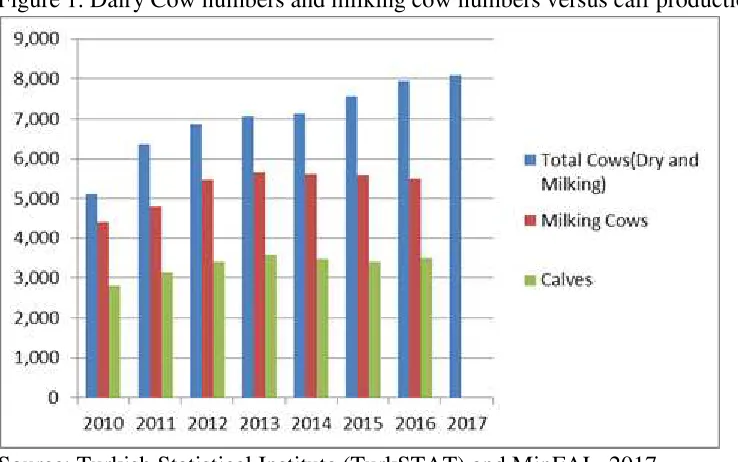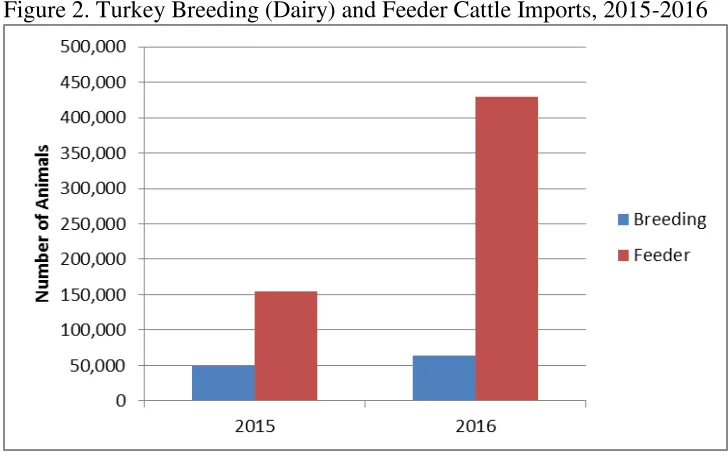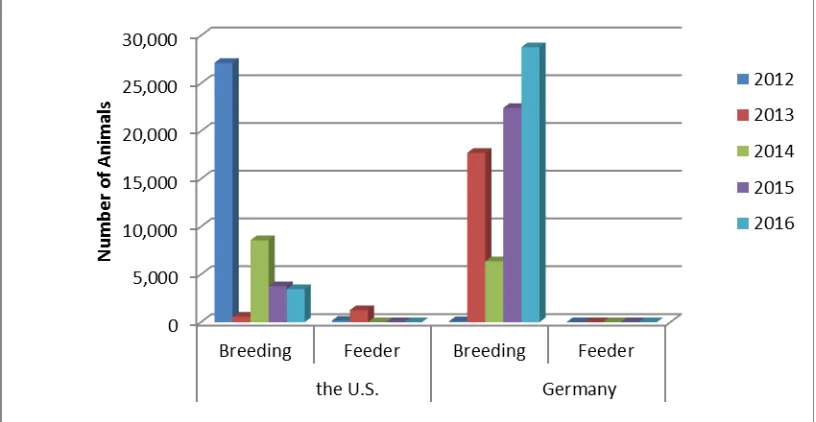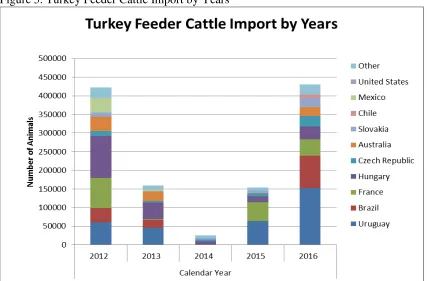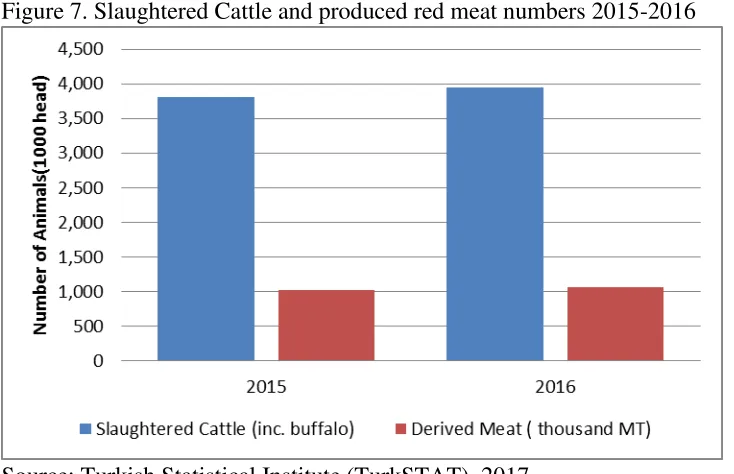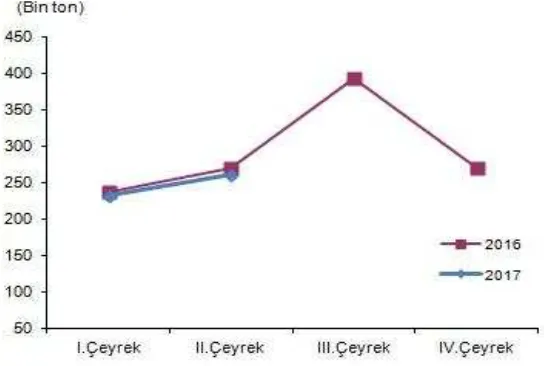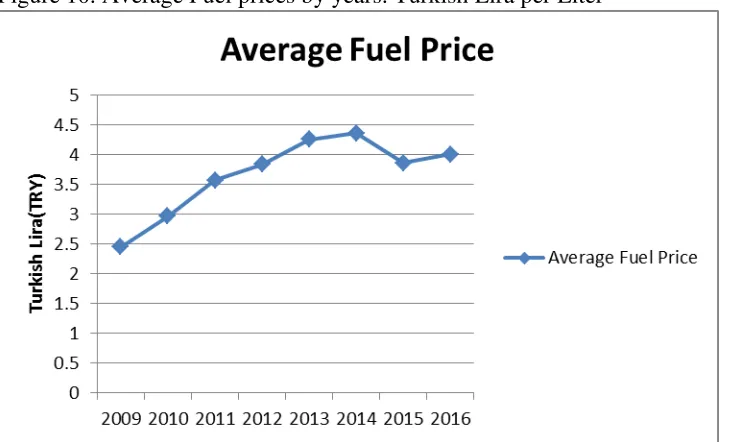THIS REPORT CONTAINS ASSESSMENTS OF COMMODITY AND TRADE ISSUES MADE BY USDA STAFF AND NOT NECESSARILY STATEMENTS OF OFFICIAL U.S. GOVERNMENT POLICY
The Government of Turkey has just assigned the new Agriculture Minister last month, Ahmet Esref Fakibaba, who has prioritized dealing with high meat prices and reducing beef meat imports. Recently milking cows have been sent to slaughter due to the high meat price and low raw milk price. Import policies continue to favor government-affiliated importers over the private sector. Dairy and beef numbers, production, and imports continue to grow, albeit slowly. The cattle population is expected to grow in 2018 due to large increases in feeder cattle imports, however, as anticipated last year, carcass weight will be stagnant because of continuously rising feed prices. According to the Turkish Statistical Institute (TurkSTAT) and Ministry of Food, Agriculture and Livestock (MinFAL), the Turkish national cattle herd is calculated at 14.2 million head in 2016 (including buffalo), which is 0.6 percent higher than the previous year. Milking cow population decreased 1.8 percent and slaughtered cattle increased 3.3 percent in 2016, compared to 2015.
Sinem Duyum, Agricultural Specialist Elizabeth Leonardi, Agricultural Attaché
Turkey Livestock and Products Annual Report 2017
Livestock and Products Annual
Turkey
Executive Summary:
With the sustained Turkish government incentives to produce calves, the calf population is forecast to slightly increase in 2017 and continue in 2018. In 2016, calves number reached 3.5 million, which is 2.6 percent higher than the previous year. However, mortality rates for calves have been high due to a lack of poor on-farm health management.
The cattle population is expected to grow in 2018 due to feeder cattle import policies, however, as anticipated last year, carcass weight is forecast to be stagnant because of high feed prices.
In August, preparations for the Muslim sacrifice holiday in early September were at full speed. Kars province, which is located in the north east of Turkey, is a crucial source for animals for slaughter to be dispatched to other locations of Turkey for the sacrifice holidays. Reportedly, in this pre-holiday period, 2,500 head of cattle and sheep were dispatched from Kars per day. Additionally, MinFAL has
prohibited sales of female animals in markets for sacrifice holiday since female animals are needed for
breeding to increase the animal inventory of Turkey, which is in line with Turkey’s national agriculture policies.
Total cattle import in 2018 is forecast to double after the new Council of Ministers’ Degree, published
on July 29, 2017 in the Official Gazette. This degree granted import permission to the Milk and Meat Board (ESK) to import of 500,000 head of cattle, 475,000 head of sheep and goat, 75,000 MT fresh or chilled beef and 20,000 MT frozen quarter carcass. This decision is valid until 12/31/2018 for cattle, sheep, goat and beef import, while carcass meat import permission is valid until 12/31/2017. Turkey imported 203,000 head of cattle in 2015, including 288 head of buffalo, and 494,000 head of breeding and feeder cattle in 2016. As seen Figure 2, feeder cattle import doubled in 2016 when compared with the previous year.
Post expects that in 2018 beef production will increase by five percent compared to 2017 since feeder cattle imports will continue in 2018. In 2017, 208,016 MT beef was produced for the first quarter, which is the same level with the same period of 2016. Post estimates that beef production in 2017 will be 4 percent higher than in 2016.
The meat supply deficiency remains to be a major problem in Turkey. Red meat consumption per capita in Turkey is estimated at 13.7 kg in 2015 and 14 kg in 2016 – of this beef has a 90 percent share.
MinFAL tried to encourage the public to consume more lamb however it has not helped to reduce meat prices in Turkey. Total beef imports in 2018 are forecast to remain the same as in 2017, since beef producers in Turkey are opposed to MinFAL liberalizing the beef import policies. Domestic producers are concerned that they would not be price competitive with imported beef and the new Agriculture Minister is assuring them he will stop importing meat in the coming years.
Turkey imported 8,400 CWT beef (carcass and boneless) in 2016 and it is also expected to remain the
same in 2017. Beef imports are considered MinFAL’s additional measure to reduce beef prices in
Turkey.
With the sustained government incentives to produce calves, the calf population is forecast to slightly increase in 2017 and continue in 2018. In 2016, calf numbers reached 3.5 million, which is 2.6 percent higher than the previous year. However, mortality rates for calves have been high due to a lack of animal health implementations and poor farm management practices. On the other hand, producers complain about the animal health conditions of calves born from imported heifers. They believe that
these calves are not adapted to Turkey’s climate and animal health environment. Calves losses are 15 percent of total calf production in Turkey while it is approximately 2 percent in the European Union. The total loss in value was nearly $12 million in 2016. In Figure One you can see the slight reduction in calf numbers, but the continued growth in overall dairy cattle population.
Cattle population is expected to grow in 2018 due to feeder cattle import policies of Turkey, however, as anticipated last year, carcass weight will be stagnant because of continuously rising feed prices.
According to the Turkish Statistical Institute (TurkSTAT) and Ministry of Food, Agriculture and Livestock (MinFAL), the Turkish national cattle herd is calculated at 14.2 million head in 2016 (including buffalo), which is 0.6 percent higher than the previous year. Milking cow population decreased 1.8 percent and slaughtered cattle increased 3.3 percent in 2016, compared to 2015. This shows that cow slaughter has recently increased due to low milk prices and high meat prices. As seen in Figure 1, cow numbers have been steadily increasing after 2010 while calf numbers have been slightly decreasing since 2014.
Figure 1. Dairy Cow numbers and milking cow numbers versus calf production 2010-2016
Source: Turkish Statistical Institute (TurkSTAT) and MinFAL, 2017
Turkey has been trying to increase its cattle population since 2010 because of climbing meat prices as a
result of a major drought in 2008. One of the latest projects of MinFAL is establishing ‘embryo
head of heifers would be inseminated with various beef breeds. The aim is to obtain Simmental-cross breed cattle from those heifers. Within those farms, fresh and frozen embryos will be produced and calves will be distributed to producers.
Subsidies
One of the important components of the National Agriculture Project is “The Model of Subsidizing Livestock Domestic Production”. The main purpose of this component is to increase the livestock
inventory in Turkey and reduce feeder cattle imports. Breeding cattle import policy is expected to continue. For further information please see GAIN report date: 04/19/2017 No: TR7018 or here. An amount of 750 TL ($212) will be granted for each calf which reaches 4 months and is vaccinated regularly. With this approach, MinFAL is supporting domestic production, however the subsidies for encouraging use of slaughterhouses for slaughter were removed from the 2017 livestock subsidies. Producers are upset by this change, and believe that subsidies for slaughtering were encouraging slaughter in sanitary health conditions and providing more accurate data keeping at slaughterhouses, which are all very positive for the sector. Additionally, they believe that this change could result a rise in unregistered slaughter of animals.
Through their subsidies, it seems that MinFAL has decided to put an emphasis on animal health issues, especially reducing calf losses and improving milk quality. For this reason, MinFAL was going to give more subsidies in 2017 to establishments free from animal diseases however it has not taken place yet.
The number of establishments which are certified “free from animal diseases” remains extremely low.
There are approximately 600 establishments categorized as free from animal disease and 56 of those are approved milking enterprises for export to the EU. As of July 2017, there are 1.5 million of registered cattle farms and 470,000 small ruminant farms in Turkey.
Sacrifice holiday
In August, preparations for the Muslim sacrifice holiday at the end of August were in full swing. Kars province, which is located in north eastern Turkey, is a crucial source for slaughtering animals to be distributed to other locations of Turkey for the sacrifice holidays. Reportedly, nowadays 2,500 head of cattle and sheep are dispatched from Kars per day before the holiday. MinFAL has prohibited selling female animals in animal markets for the sacrifice holiday since female animals for breeding should be protected to increase the animal inventory of Turkey. However, this decision has led to an increase of red meat prices at markets due to low supply of animals available for slaughter. It is expected that red meat prices will continue increasing until the sacrifice holiday, which will be held on August 31- September 1, 2017.
Every year in Turkey 3.5 million animals (approximately 950,000 head of cattle, 2.5 million of sheep) are slaughtered for the sacrifice holiday. If total animal numbers are taken into consideration, this amounts to about eight percent of total population is sent to sacrifice holiday per year. While the price of live weight cattle was 28 TL ($8) per kg last year, the current price has increased 35 TL ($10) in 2017 due to the continued high feed prices and other increasing costs. Despite high cattle price, raw milk reference price was announced as 1.30 TL ($0.30) by Turkish National Milk Council. From the point of
producers, this price is very low compared to producers’ high cost of production while milk price has
been getting higher at supermarkets.
Total cattle import in 2018 is forecast to double after the new Council of Ministers’ Degree published on 07/29/2017 in the Official Gazette regarding import permission granted to Milk and Meat Board (ESK) to import of 500,000 head of cattle, 475,000 head of sheep and goat, 75,000 MT fresh or chilled beef and 20,000 MT frozen quarter carcass. Turkey imported 203,000 head of cattle including 288 head of buffalo in 2015 and 494,000 head of breeding and feeder cattle in 2016. As seen in Figure 2, feeder cattle imports doubled in 2016 compared with the previous year.
Figure 2. Turkey Breeding (Dairy) and Feeder Cattle Imports, 2015-2016
Source: Turkish Statistical Institute (TurkSTAT) and MinFAL, 2017
Turkey imported 3,465 head of breeding cattle ($11 million) in 2016 from the United States, while in 2015 it was 3,778 head of breeding cattle ($14 million). There is an 8 percent decrease between 2015 and 2016. One reason behind this decrease appears to be that Germany has become stronger on business
connections with Turkey’s dairy sector and increased its dairy cattle exports to Turkey. On the other hand, high prices of the U.S. breeding stock, partnered with a strong dollar, meant that the U.S. was not able to be competitive compared to EU prices in recent years.
Source: Turkish Statistical Institute (TurkSTAT), 2017
Figure 4. Breeding Cattle Import by Month, Jan.-Jun. 2016 vs 2017 Comparison
Source: Turkish Statistical Institute (TurkSTAT), 2017
Regarding feeder cattle import, producers are keen for this to continue and support MinFAL to continue its policy, as they did in 2016. The sector believes that meat prices would be able to be kept under control with continuous feeder cattle imports, but wouldn’t be as hurt as if the government allowed the import of beef. Turkey imported 430,068 head of feeder cattle in 2016. In 2017, it is expected to
increase at least 80 percent above 2016 numbers with MinFAL’s current live cattle import policies.
2015 2016
Austria 2,138 4,338
Hungary 14,652 34,627
Belgium 144 2,406
Bulgaria - 70
France 50,657 43,774
Slovakia 6,538 23,048
Czech Republic 8,791 28,180
Latvia 2,525 8,734
Lithuania 210 1,810
Estonia 3,138 2,366
Italy 31 5,483
Australia 1,107 23,887
Uruguay 64,263 152,370
Chili - 10,583
Brazil - 86,982
United States - -
Ireland - 1,327
Source: Turkish Statistical Institute (TurkSTAT), 2017
Figure 5. Turkey Feeder Cattle Import by Years
Source: Turkish Statistical Institute (TurkSTAT), 2017
was the second exporter of feeder cattle to Turkey, live cattle export from France decreased in 2016 when compared with the previous year since the EU countries was struggling with Bluetongue virus and Schmallenberg virus. MinFAL has been implementing the following requirements for Schmallenberg virus:
For pregnant animals (cattle, sheep and goat) coming from the EU,
For male breeding animals coming from the EU,
I, the undersigned official veterinarian certify that the animals listed in certificate No………..(1)
1. were subjected to measures aimed to protect them against insect vectors, which can transmit the SBV, during their entire stay at the collection centre/quarantine station,
2. originated from holdings in which no case of the Schmallenberg virus (SBV) has been officially notified
3. (a) were tested and found sero-positive (test tarihi/test date:_______ (2)) and PCR-negative (test tarihi/test date:_________ (2) ) within 21 days before exportation (4).
(Please add the test documents) or
(b) were found negative by PCR-test carried out on a blood sample taken seven days after coming to the quarantine station in which protective measures against insect vectors were taken (
MinFAL has been implementing the following requirements for Bluetongue virus:
I the undersigned official veterinarian certify that fattening animals listed in certificate No
………,
1. were vaccinated with an inactivated vaccine against blutongue virus serotype 4 at least 60 days before dispatch with being within the immunity period of time guaranteed in the specifications of the vaccine.
Vaccination date :
(Please add vacination documents(2)
2. were tested negative against bluetongue virus with virus identification test (PCR) during the last 14 days before dispatch.
Test date:
(Please add test documents(2))
3. are originated from establishments that not located within a radius of 20 km from any Bluetongue outbreak reported by OIE.
For breeding cattle from the BT infected EU countries,
I the undersigned official veterinarian certify that breeding animals listed in certificate No
………,
1. (2)Either were vaccinated with an inactivated vaccine against bleutongue virus serotype 4 at least 60 days before dispatch with being within the immunity period of time guaranteed in the specifications of the vaccine
2. were tested negative against bleutongue virus with virus identification test (PCR) during the last 14 days before dispatch
Test date:
(Please add test documents(3))
3. are originated from establishments that not located within a radius of 20 km from any Bluetongue outbreak reported by OIE.
Those above declarations must be attached to original health certificates and must be endorsed by official veterinarian of exporting countries.
Source: Turkish Statistical Institute (TurkSTAT) and MinFAL, 2017
Customs taxes:
Last year, with the Council of Ministers’ decision published on May 3, 2016, zero percent custom tax
was applied for government-affiliated bodies of the General Directorate of Agricultural Establishments (TIGEM) and Meat and Milk Board (ESK) for importing of breeding and feeder cattle. For further information, please see GAIN report date: 8/31/2016 No: TR6039 here. Then in June 27, 2017, with
another Council of Minister’s decision, the custom tax was reduced for the private sector as well. This
was just valid for slaughtering cattle and carcass meat (Chart 2).
Again, the new Council of Minister’s decision was published on July 29, 2017 to grant zero custom tax
for government-affiliated body of Milk and Meat Board (ESK) to import of 500,000 head of cattle (HS code: 0102), 475,000 head of sheep and goat (HS code: 0104), 75,000 MT beef (HS code: 0201) and 20,000 MT of quarter carcass meat (HS code: 0201.20.20.00.00). This decision is valid until 12/31/2018 for cattle, sheep and goat and beef import. Carcass meat import permission is valid until 12/31/2017.
Chart 2. 2016-2017 Turkish Custom Duties of Live Animals/Carcass Meat Imports
2016 2017
production and will cut any speculative actions by the private sector that led to marked up beef prices in Turkey.
Although the custom tax of feeder cattle import for the private sector has been implemented as 10 percent, MinFAL was not giving import permission (control documents) to private sector importers, which effectively only allowed imports by the Meat and Milk Board (ESK). Reportedly, MinFAL now may be allowing private sector to import feeder cattle with 10 percent custom tax due to the sacrifice holiday and insufficient cattle numbers to be slaughtered. Although there has been no written
declaration about the decision, the permission given to private sector is rumored that it will be for animals to be imported from South American countries, but because it is not officially announced it could change.
Production, Supply and Demand Data Statistics:
Production:
Post expects that in 2018 beef production will increase by five percent compared to 2017 since feeder cattle imports will continue in 2018. In 2017, 208,016 MT of beef was produced in the first quarter, which is similar to the same period of 2016. Post estimates that beef production in 2017 will be slightly higher than 2016, likely a four percent increase.
In 2016, beef production (including buffalo) amounted to 1.059 million tons, which is 4 percent higher than 2015. Beef production did not increase in 2016, as Post had estimated it would in the last report. Post estimated higher production since 2016 feeder cattle imports doubled.
Figure 7. Slaughtered Cattle and produced red meat numbers 2015-2016
Source: Turkish Statistical Institute (TurkSTAT), 2017
As with 2015, the vast majority of red meat consumed in 2016 was from cattle, though the majority of animals slaughtered are sheep.
Source: Turkish Statistical Institute (TurkSTAT), August 2017
From point of producers and consumers, red meat prices have always been a problem for Turkey. Despite the fact that Turkey has been importing cattle for years, red meat prices have not been reduced to the desired level. There is large difference (approximately 100 percent) from producers’ price and retail prices. Producers’ prices are largely determined by the Milk and Meat Board, a government affiliated organization. Red meat prices have increased by 12 percent in 2016 when compared to 2015, which is higher than the normal food inflation rates, which are also high in general.
Figure 9. Carcass prices by months of 2016 and 2017.
Source: Milk and Meat Board (ESK), 2017. (Note: As of August 7, 2017, 1 $= 3.5 TRY)
costs. Additionally, 60-70 percent of total feed used for livestock production is imported and Turkey's currency, the Turkish Lira, hit an all-time low level against the U.S. dollar in 2017 which makes
imported feedstuff relatively expensive when the final product will be sold in the domestic market (and not exported for dollars).
Figure 10. Average Fuel prices by years. Turkish Lira per Liter
Source: Directorate General of Plant Production, 2017. (Note: As of August 7, 2017, 1 $= 3,5 TRY)
Chart 3. Compound Feed Production in Turkey, 2014-2017* (tons) Year Broiler
Feed
Laying Hens Feed
Feeder Cattle Feed
Cow’s
Feed
Others Total
2014 3,979,945 2,480,547 3,386,565 5,621,664 2,534,895 18,003,616 2015 4,779,916 3,417,209 3,320,221 5,384,586 3,203,051 20,104,983 2016 3,827,073 5,840,262 4,566,237 2,958,232 3,210,048 20,401,852 2017* 1,836,742 2,374,242 1,784,287 1,484,121 1,643,973 9,123,366 Source: DG of Food and Control, 2017, * shows the data until June
Consumption:
There still is a meat supply deficiency in Turkey. Red meat consumption per capita in Turkey is estimated at 13.7 kg in 2015 and 14 kg in 2016 – of this, beef has a 90 percent share. MinFAL tried to encourage the public to consume more lamb however it has not helped to reduce meat prices in Turkey.
Source: Turkish Statistical Institute (TurkSTAT), August 2017, Price Fluctuation from 2009 to 2015 is shown in GAIN report date: 11/16/2015 No: TR5043 or here. (Note: As of August 7, 2017, 1 $= 3,5 TRY)
One third of total produced beef is consumed in Istanbul. The value-added tax (VAT) on meat is eight percent for all of Turkey. The Butchers Federation believes that VAT should be reduced to one percent by the Turkish government in order to reduce meat prices.
Trade:
Total beef import in 2018 is forecast to remain the same as in 2017 since beef producers in Turkey do not support MinFAL to increase beef imports. They are concerned that they will not be competitive with imported beef on price base.
Turkey imported 8,400 CWT beef (carcass and boneless) in 2016 and it is also expected to remain the
same in 2017. Beef imports are considered MinFAL’s additional measure to reduce beef prices in
Turkey, but they are not the primary approach.
With the Council of Ministers’ decision published on 7/29/2017, only ESK has been granted the right to import 75,000 MT (product weight) of meat (HS code 0201) and 20,000 MT of quarter carcass meat (HS code: 0201.20) with zero percent customs tax by December 31, 2018, though this did not include any information on which countries this meat can be sourced from. The authorized slaughterhouses in exporting countries are published at MinFAL website,
http://www.tarim.gov.tr/Konular/Veteriner-Hizmetleri/Ihracat-Ithalat/Ithalat, and are:
Name of the Establishments Approval Number Authorization
Flanders Meat Group Zele BE56 Slaughter and Cutting Plant
GROUPE BIGARD FR 59.225.104 CE Slaughter and Cutting Plant
SOCOPA VIANDES FR 85.191.004 CE Slaughter and Cutting Plant
ELIVIA FR 14.752.010 CE Slaughter and Cutting Plant
SOCIETE VITREENNE D'ABATTAGE FR 22.371.001 CE Slaughter and Cutting Plant SOCIETE FOREZIENNE D'ABATTAGE FR 42.094.001 CE Slaughter
SOC VIOL FRERES FR 44.036.001 CE Slaughter and Cutting Plant SOCIETE VITREENNE D'ABATTAGE FR 35.152.001 CE Slaughter and Cutting Plant
Biernacki PL 30063801 Slaughter
Mokobody PL 14260112 Slaughter
Zakrzewscy PL 14293801 Slaughter
İnterbeef PL30183805 Slaughter
Pini Beef PL06140205 Slaughter
MC Keen-Beef Ubojnia Sp. Z.o.o. PL30270106 Slaughter Zaklady Miesne Luniewscy Eugeniusz Luniewski PL20130101 Slaughter Sokolow Spolka Akcyjna Oddzial w tarnowie PL12630215 Slaughter
Osi Poland Foodworks Sp. Z.o.o PL02043801 Slaughter
SC AGRO-INVEST PROD SRL RO-301 Slaughter
SC MARIA TRADING SRL RO-2 Slaughter
S.C. BRUTUS IMPEX S.R.L. RO-462 Slaughter
S.C. PRODİMCOM S.A. RO-327 Slaughter
S.C. ALSİM N.M.P. S.R.L. RO-580 Slaughter
Martinez Loriente S.A. ES 10.20735/V-CE Slaughter
SIA SENLEJAS LV A009201 Slaughter
SIA CESU GALAS KOMBİNATS LV A009143 Slaughter
SIA BIOMEAT LV A050394 Slaughter
There has not still been any written restriction by the government for the private sector to import meat, but the custom tax implemented is 40 percent, which has proved prohibitive because meat imported with this tax would not be competitive in the market.
Chart 4. Turkey’s Beef Imports (MT) from 2015-2017 Partner Country Quantity
2015 2016 2017*
France - -
Germany - -
Poland 8,800(HS:020120) 20.5(HS:020120) 1,900(HS:020120)
Bosnia and Herzegovina
Source: Turkish Statistical Institute (TurkSTAT), 2016, * January-March data is shown
Production, Supply and Demand Data Statistics:
Meat, Beef and
